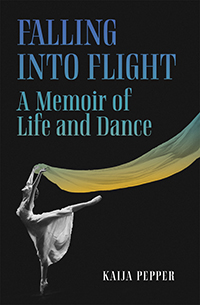Reviews
Nonfiction Review by Stacey Engels
Kaija Pepper, Falling Into Flight: A Memoir of LIfe and Dance (Winnipeg: Signature Editions, 2020). Paperbound, 168 pp., $19.95.
 Kaija Pepper’s Falling into Flight is a slim volume; one could mistake it for a collection of poetry. It might be fair to assume a memoir will bear similarities to a novel and that these may not stop at length or structure or cover art. The narrative will often employ many of the same techniques as long fiction: strong character development and emphasis on setting, a driving plotline with a cliffhanger at the end of every chapter, flashbacks promising us understanding of a key turning point in the past and flashforwards promising us understanding of how the writer has been made whole over time. Falling is not that kind of book.
Kaija Pepper’s Falling into Flight is a slim volume; one could mistake it for a collection of poetry. It might be fair to assume a memoir will bear similarities to a novel and that these may not stop at length or structure or cover art. The narrative will often employ many of the same techniques as long fiction: strong character development and emphasis on setting, a driving plotline with a cliffhanger at the end of every chapter, flashbacks promising us understanding of a key turning point in the past and flashforwards promising us understanding of how the writer has been made whole over time. Falling is not that kind of book.
It is clear that we are embarking on a different type of literary experience as soon as we reach the “Contents,” which look more like the program for an evening of classical music than a conventional chapter breakdown. This prepares the reader to enter Pepper’s world: one of dance and music, silences and currents, yearning and reality. The twenty‐three chapters are divided into five sections (or movements?), and one notes a recursive quality in their titles: “My Renegade Body,” “My Mother’s Renegade Body,” “The Small Dance Inside of Me,” “Returning to the Dance Inside.” In this way, too, we are primed to enter a narrative that is like classical music, in which some themes bend back on themselves for further exploration in new keys and tempos.
Pepper’s is not an unusual story: at mid‐life, she finds herself in the office of a psychiatrist after exhausting her options with doctors who cannot resolve all the physical symptoms that have begun to assail her in the wake of her parents’ deaths. Initially unnerved by the openendedness of Dr. B’s questions, she soon warms to him and gradually learns how to view and articulate the events of her life so that she becomes the protagonist of her own story. When Dr. B tells her she is the opposite of a narcissist, she is initially flattered and then “discover[ s] that the opposite was to have no center, only a void from which I somehow had to find my voice and send it out to fill the room with ‘me.’”
In addition to sparking forgotten memories, offering new language for old wounds, and freeing both the girl (née Susan) and the woman (rechristened Kaija) into the present, psychotherapy shakes the foundation of Pepper’s identity as a critic and dance writer and precipitates her first forays into writing personal narrative. Toward the end of her five years with Dr. B (and the end of the first “movement”), when she tells him she has formed a writing group with friends and is tackling memoir, he replies encouragingly: “Being able to write about yourself is a sign of presence.”
Though there are editorial lapses throughout the book—a recurring metaphor is used too often, a crescendo arrives at a muted climax— reading this memoir is an intimate, even humbling experience. Without realizing it, we have in fact accepted an invitation to witness an artist writing herself into being. As we progress through the chapters, the selves she was become sharper in outline, like photographs in a darkroom: we meet the child in a tutu, the teenager hitchhiking crosscountry in search of the autonomy she has always craved, and the adult who learns, through marriage to a much older man, that time works differently when we have passed life’s zenith. The self‐possession of the woman and writer Pepper has become fills in those outlines.
Falling into Flight will be especially resonant for women born into the second wave of feminism, or for readers curious to understand how recently it was that middle‐class North‐American girls were raised to see themselves through boys’ eyes and through the mercilessly reductive lens of popular culture and the media (plus ça change…). Pepper’s gradual emergence, therefore, is not only a matter of finding a way to cleave her quiet self out of the shadow of her much more dramatic mother, but to own and embody the self who, for decades, navigated cautiously through the deeply male‐dominated worlds of higher education, employment, and art‐making.
Kaija Pepper is widely known in Canadian dance circles. She has written three books on Canadian dance, contributed to numerous national and international publications, and serves as dance critic at The Globe and Mail, editor of Dance International, and sessional instructor at Simon Fraser University. She is an authority in her field and no stranger to the written word, yet Falling into Flight—born out of grief, mysterious physical ailments, psychotherapy, and deep, complicated love for both her late parents and her own life as an artist—vibrates with the vulnerability of a dancer who has taken her place in the spotlight for the first time.
—Stacey Engels









